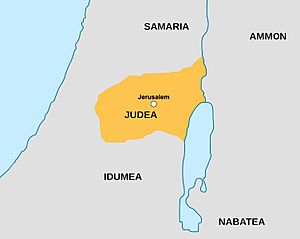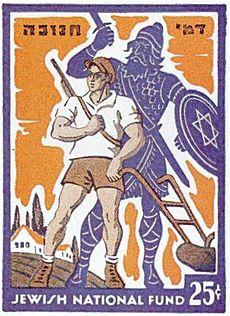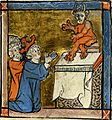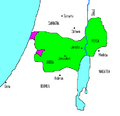Maccabean Revolt facts for kids
Quick facts for kids Maccabean Revolt |
|||||||
|---|---|---|---|---|---|---|---|
 Jerusalem and Judea during the revolt |
|||||||
|
|||||||
| Belligerents | |||||||
| Maccabees | Seleucid Empire | ||||||
| Commanders and leaders | |||||||
| Mattathias † Judas Maccabeus ☠ Jonathan Apphus Eleazar Avaran ☠ Simon Thassi John Gaddi ☠ |
Antiochus IV Epiphanes † Antiochus V Eupator † Demetrius I Soter † Lysias † Gorgias Nicanor ☠ Bacchides |
||||||
| Units involved | |||||||
| Judean rebels | Seleucid army | ||||||
The Maccabean Revolt (Hebrew: מרד החשמונאים) was a big fight by Jewish people called the Maccabees. They fought against the Seleucid Empire, which was a powerful kingdom. This revolt also pushed back against Greek culture that was changing Jewish life.
The main part of the revolt happened from 167 to 160 BCE. At first, the Seleucids kept control of Judea, the Jewish homeland. But the fighting between the Maccabees, Jewish people who liked Greek culture, and the Seleucids went on until 134 BCE. In the end, the Maccabees won their independence.
Contents
Why Did the Maccabean Revolt Start?
In 168 BCE, the Seleucid King Antiochus IV Epiphanes started to stop Jewish religious practices. It's not fully clear why he did this. It might have been because he thought a fight among Jewish priests was a full rebellion.
Jewish traditions were banned. The city of Jerusalem came under direct Seleucid control. The Second Temple in Jerusalem, a very important Jewish holy place, was used for a mix of Pagan and Jewish worship. This harsh treatment caused the very revolt Antiochus IV had worried about.
Who Led the Maccabees?
A group of Jewish fighters, led by Judas Maccabeus (also known as Judah Maccabee) and his family, started to rebel in 167 BCE. They wanted their freedom. These rebels became known as the Maccabees. Their story was later written down in the books of 1 Maccabees and 2 Maccabees.
Key Events of the Revolt
The rebellion began as a small, hidden movement in the countryside of Judea. They would raid towns and scare Greek officials far from the main Seleucid army. Over time, the Maccabees grew into a proper army. They became strong enough to attack fortified Seleucid cities.
Capturing Jerusalem and Hanukkah
In 164 BCE, the Maccabees captured Jerusalem. This was a very important early victory. After taking the city, they cleaned the Temple and rededicated its altar on the 25th day of Kislev. This event is why the Jewish festival of Hanukkah is celebrated every year.
The Seleucids eventually gave in and allowed Judaism again. However, the Maccabees were more radical. They weren't happy with just being able to practice their religion under Seleucid rule. They kept fighting for a complete break from the Seleucids.
Continued Resistance and Independence
Judas Maccabeus died in 160 BCE at the Battle of Elasa. He was fighting against the Greek general Bacchides. After this, the Seleucids took back direct control for a while. But parts of the Maccabee army, led by Judas's brother Jonathan Apphus, kept fighting from the countryside.
Later, problems within the Seleucid Empire gave the Maccabees a chance for real independence. In 141 BCE, Simon Thassi, another brother, successfully forced the Greeks out of their fortress in Jerusalem. An alliance with the powerful Roman Republic helped make sure their independence lasted. Simon then started an independent Jewish kingdom called the Hasmonean kingdom.
The Maccabean Revolt had a huge impact on Jewish national pride. It showed that it was possible to fight for political freedom and stand up against unfair government actions.
Legacy of the Maccabees
The Jewish festival of Hanukkah celebrates the rededication of the Temple. This happened after Judas Maccabeus's victory over the Seleucids. A Jewish story says that the Maccabees found only a small jar of pure oil. This oil was only enough to light the Menorah (a special lamp) for one day. But, it miraculously lasted for eight days, which gave them time to get more oil.
During the time of the Hasmonean kingdom, Hanukkah was very important. It was like an "Independence Day" for the Hasmoneans. It celebrated the success of the revolt and showed that the Hasmonean rulers were rightful leaders. Jewish people living in other lands also celebrated it. This helped create a feeling of shared Jewish identity. Hanukkah was seen as a day of freedom for all Jews, not just those in Judea.
Hanukkah continued to be celebrated even after the Hasmonean rule ended. Its importance grew again in the 1900s. This led to new interest in the Maccabees and their story.
Other Celebrations and Ideas
The Jewish victory at the Battle of Adasa also led to an annual festival. It is not as well-known as Hanukkah. The defeat of Seleucid general Nicanor is celebrated on 13 Adar as Yom Nicanor.
The difficult time of the revolt helped shape a type of writing called apocalypse. It also increased Jewish apocalypticism, which is the belief in a future end of the world. The idea of an evil ruler like Antiochus IV attacking Jerusalem became a common theme later during Roman rule. This idea also influenced Christian beliefs about the Antichrist.
The persecution of Jews by Antiochus and the Maccabees' response changed Jewish ideas about rewards and punishments from God. Before, it was thought that following God's laws led to good things in life. Disobeying them would lead to disaster. But under Antiochus IV, Jews suffered precisely because they followed Jewish law. The most religious Jews suffered the most. This led to new ideas. People began to believe that those who suffered in this life would be rewarded after death. The Book of Daniel, for example, talks about a future resurrection of the dead. The book of 2 Maccabees describes a woman with seven sons who were killed under Antiochus. But they would be rewarded after their deaths.
Inspiration for Future Movements
The Maccabean Revolt was a victory of the "few over the many." It inspired future Jewish resistance groups, like the Zealots. Later famous revolts include the First Jewish–Roman War (66–73 CE) and the Bar Kochba revolt (132–136 CE).
After these later revolts failed, Jewish people started to see the Maccabean Revolt in a more spiritual way. They focused on the Hanukkah story and God's miracle of the oil. They focused less on plans for an independent Jewish state with an army. The Maccabees were also discussed less over time. They appear rarely in the mishnah, which are Jewish writings. This was partly because rabbis were unhappy with how the Hasmoneans ruled after the revolt. Even when stories were set during the Maccabean period, Judas's name was sometimes removed. This was to avoid making the Hasmonean family too much of a hero.
The books of Maccabees were not as important in Jewish tradition. They were not included in the Jewish Tanakh (Hebrew Bible). Christians, however, created more art and literature about the Maccabees during the Middle Ages. This is because the books of Maccabees were part of the Catholic and Orthodox Biblical canon. Medieval Christians saw the Maccabees as early examples of chivalry and knighthood. The Maccabees were also mentioned during the Crusades as holy warriors to copy. In the 1300s, Judas Maccabeus was named one of the Nine Worthies. These were medieval heroes that knights tried to be like.
Modern Interest in the Maccabees
Jewish interest in the Maccabees grew again in the 1800s and early 1900s. Jewish writers and artists saw the Maccabees as examples of independence and victory. People who supported Jewish nationalism at that time saw the Maccabees' past success as a sign of what was possible. This influenced the early Zionist movement, which aimed to create a Jewish homeland.
A British Zionist group formed in 1896 is called the Order of Ancient Maccabeans. The Jewish sports group Maccabi World Union is also named after them. The revolt is featured in plays by writers like Aharon Ashman, Ya'akov Cahan, and Moshe Shamir. Many groups in the modern state of Israel are named after the Maccabees and the Hasmoneans, or honor them in other ways.
See also
 In Spanish: Revuelta de los macabeos para niños
In Spanish: Revuelta de los macabeos para niños
Images for kids
-
A map of Palestine at the start of the Hasmonean dynasty.
-
Eleazar Avaran being trampled by a war elephant (illustration by Gustave Doré in 1866).
-
Map of the kingdoms in 188 BCE. By 167 BCE, the start of the revolt, the Antigonid Kingdom of Macedonia had been mostly conquered by the Roman Republic.









